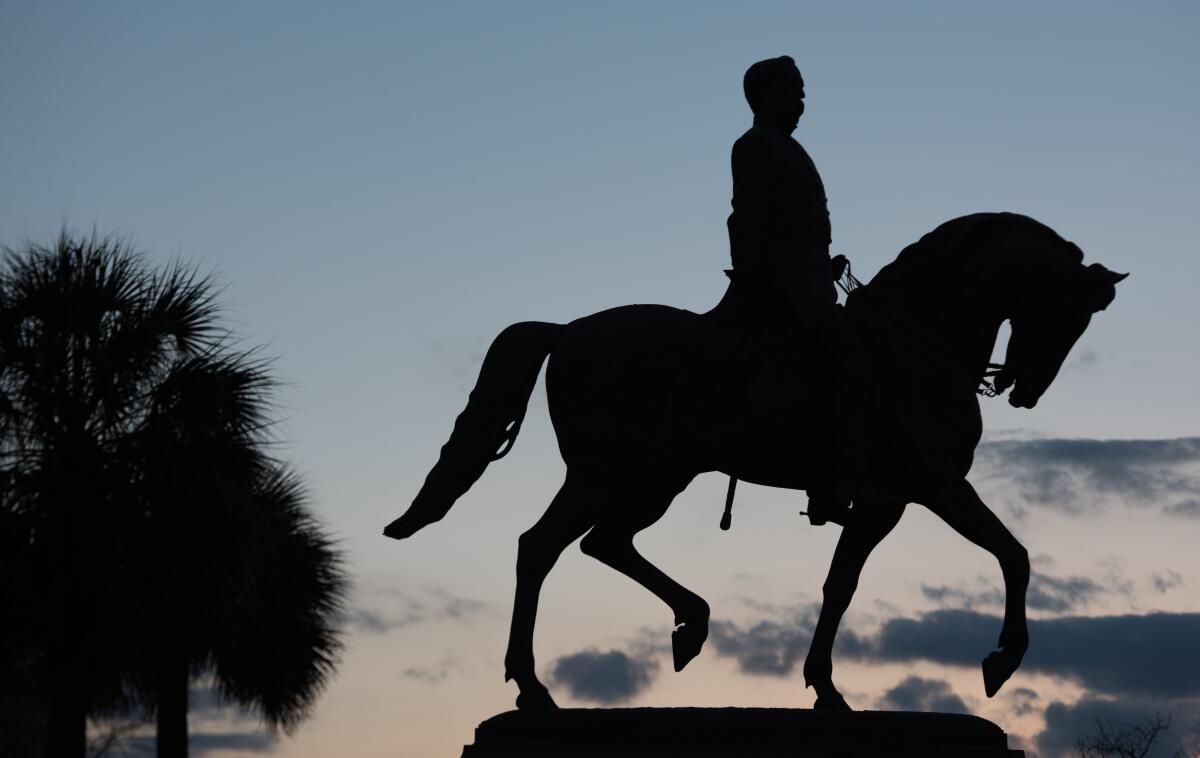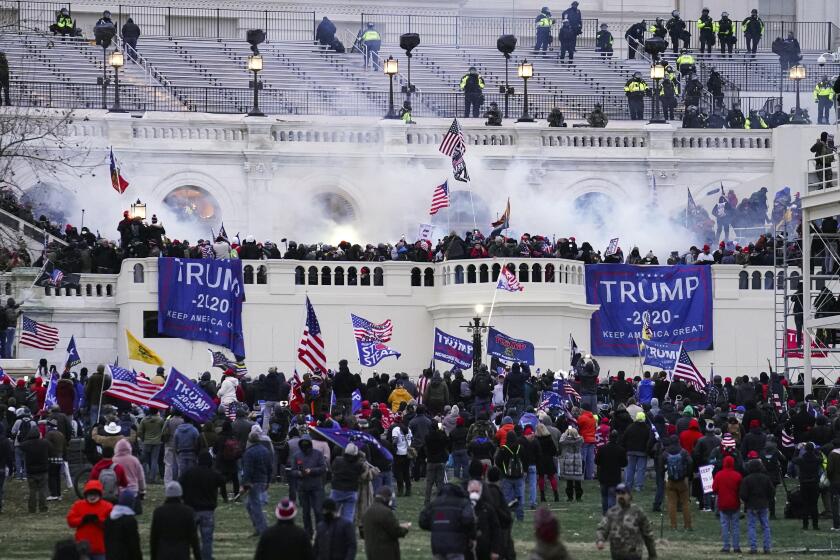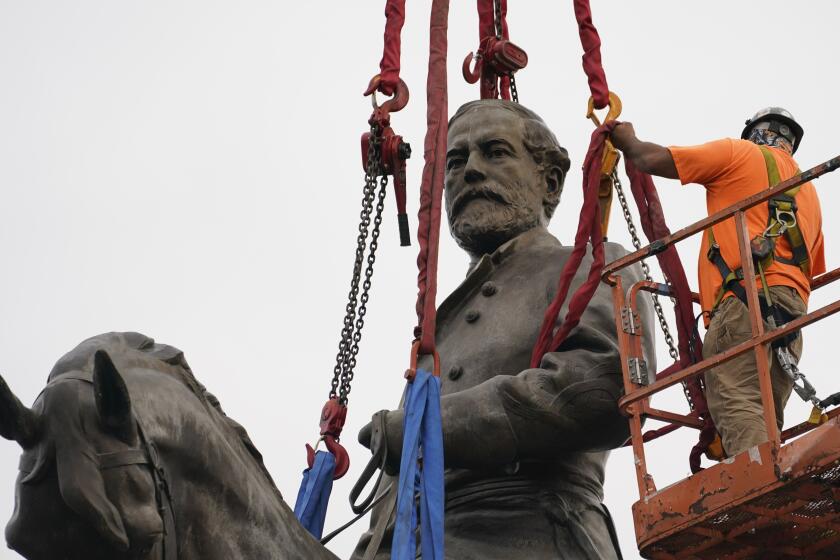Trump is running despite the 14th Amendment. He’s not the first insurrectionist to do so

- Share via
Efforts to use the 14th Amendment to keep Donald Trump off the 2024 ballot are moving forward across the country. Lawsuits have been filed in Colorado, New Hampshire, Minnesota and California; lawmakers in California have asked the state attorney general to seek a court opinion on the subject.
Under Section 3 of the 14th Amendment, anyone who took an oath to support the Constitution and then engaged in insurrection against the United States is prohibited from holding federal office. Those pressing the suits argue that the section disqualifies Trump from the presidency because of his efforts to overturn the 2020 election.
Excluding one of the leading presidential candidates from the election is a momentous possibility that raises many questions. Some are relatively easy to answer; others require a deeper look into the history of the country and the amendment at issue.
Federalist Society legal scholars say Trump ‘engaged in’ and gave ‘aid and comfort to’ insurrection, violating the 14th Amendment’s disqualification clause.
Let’s start with some easy ones. Opponents of disqualification argue that Section 3 can’t be applied without a criminal conviction or a federal statute enforcing it. They’ve even claimed that it doesn’t cover the president because he is not an officer of the United States.
These objections are insubstantial in my view. No other constitutional qualification for the presidency — such as being at least 35 years old and a natural-born citizen — requires a court finding or a statute to take effect. No other section of the 14th Amendment requires enforcement legislation. And someone who holds the office of the president is pretty clearly an officer of the United States.
How Section 3 should be enforced, and by whom, is a slightly harder question, but the answer is already emerging. Someone will obtain a court ruling that Trump is or is not qualified to be president, the losing party will appeal, and the case will go to the Supreme Court. The justices will give us an answer that will apply nationwide.
‘Interpreting the Constitution and leaving the decision to keep a candidate off the ballot to state officials does not promote democracy,’ says a reader.
But what should that answer be? On this question, it’s useful to think about the history of the provision.
Section 3, like the rest of the 14th and two other amendments, is a product of Reconstruction, the period after the Civil War when Congress sought to put the nation on a new course of inclusion, equality and democracy. The 13th Amendment abolished slavery, the 14th made formerly enslaved people citizens and gave them protections from state discrimination, and the 15th conferred a right to vote regardless of race.
Section 3 is a democracy-protecting provision. It excludes from office those who have proved themselves enemies of democracy by breaking their oath to support the Constitution.
The Constitution disqualifies those who “engaged in insurrection” from holding office, and two conservative law professors say that applies to the former president.
In 1868, the year the 14th was adopted, that meant people who sided with the Confederacy in the Civil War. But Section 3 does not limit itself to Confederates. The question is how to apply it today.
Conservative constitutional originalists William Baude and Michael Stokes Paulsen have argued that the 14th Amendment’s drafters had a broad understanding of what counts as insurrection and what counts as engaging in it. To be faithful to the original understanding of the text, they say, we must exclude Trump from office. Prominent historians such as Mark Graber and Gerard Magliocca agree.
But others argue that banning a leading contender from the presidential ballot would be undemocratic. As bad as Jan. 6 was, they say, it was nothing like the Civil War, and Trump’s supporters will not take it well if he is barred from running. The answer, they argue, is to defeat Trump at the ballot box.
On March 2, 1867, Congress abolished the governments of the Confederate states and forced them to create new constitutions and to ratify the 14th Amendment. That act remade America.
History, both recent and not so recent, offers some insight here too.
It is certainly true that Trump’s supporters will react poorly if he is not allowed to run. But we’re in this situation because of the way Trump and his supporters reacted to losing an election in which he was able to run. “Beat him at the ballot box” is a less convincing prescription if your opponent will not accept defeat.
It is also true that Jan. 6, 2021, was very different from the Civil War. It was certainly different in scale: The Civil War killed three-quarters of a million Americans, carnage unsurpassed in our history.
But it was also different in its goal and rationale. The secessionists of the 19th century wanted to break away from the United States and start their own country. Confederate leader Jefferson Davis was their president, they declared, not Abraham Lincoln.
The Jan. 6 insurrectionists, by contrast, wanted to retain Trump as president of the United States. They weren’t trying to separate from the country; they were trying to take it over.
Stopping the lawfully elected president from taking office, keeping another in his place and doing so through violence and intimidation — that counts as insurrection by any standard. And the historical moment it evokes is less the Civil War than Reconstruction. That is the period that reveals what happens when the enemies of democracy take power.
After the 14th and 15th Amendments gave citizenship and voting rights to the formerly enslaved, multiracial democracies emerged in the South as Black and white Republicans came together to form electoral majorities. But their opponents would not accept the election results.
Close, disputed elections unfolded at both the national and state levels in 1876. The contests were marred by fraud and violence on the part of white supremacist paramilitary groups such as the Red Shirts, in some ways forerunners of the Proud Boys and the Oath Keepers.
In South Carolina, former Confederate Gen. Wade Hampton ran for governor against Republican candidate Daniel Chamberlain. Both sides claimed victory, though Hampton’s claim relied on reports from counties showing more votes cast for him than their total registration.
For months, South Carolina had two governments, each claiming to be legitimate. But the Republicans needed federal troops to keep the Red Shirts at bay, and when President Hayes ordered the troops to stand down, Chamberlain fled the state and Hampton took over.
But wasn’t Hampton barred from office by Section 3? Yes, but he became eligible to serve in 1872, when Congress passed a general amnesty that lifted the ban for most former Confederates. So he provides a useful case study of what happens when an enemy of democracy is allowed to become chief executive.
The results are not reassuring. Under Hampton, Democrats and Red Shirts restructured the political process to ensure that they would not lose any more elections.
In 1876, South Carolina had 90,000 Black registered voters. By 1900, there were fewer than 3,000. As of 1940, Black voter registration across the South stood at 3%. Meaningful improvement did not come until the federal Voting Rights Act of 1965.
Hampton, the Confederate general, went on to serve only one more term as governor, resigning in 1879 to become a U.S. senator. But his party held the South Carolina statehouse, often unopposed, until 1975.
“What kind of government do we have?” a woman reportedly asked Benjamin Franklin as he left the Constitutional Convention. “A republic,” he famously answered. “If you can keep it.” Hand your republic over to the enemies of democracy, and it could take a hundred years to get it back.
Kermit Roosevelt is a professor at the University of Pennsylvania’s Carey Law School and the author of “The Nation that Never Was: Reconstructing America’s Story.”
More to Read
A cure for the common opinion
Get thought-provoking perspectives with our weekly newsletter.
You may occasionally receive promotional content from the Los Angeles Times.













